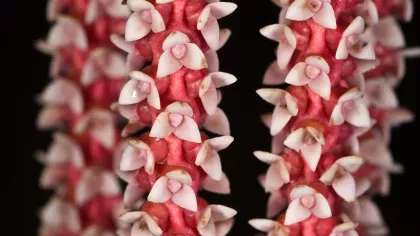When it comes to genomes, size matters
Jaume Pellicer and colleagues from Kew's Jodrell Laboratory describe the immense variation in the amount of DNA in flowering plants and why, when it comes to genomes, size really does matter.

The immense variation in the amount of DNA contained in the cells of organisms has long fascinated scientists. Known as the genome size (GS), or C-value of a species, the amount of DNA in one entire copy of the genome can be measured either by its mass (in picograms, pg) or as the total length of the DNA in millions of base pairs (megabases, Mb).
The genome size of eukaryotes, in particular, is of great interest. These are organisms whose DNA is bound within a nucleus and includes all plants, animals, fungi and almost all multi-cellular forms of life. The amount of DNA in eukaryotes is not correlated with the number of genes and the huge variation in genome size within this group is therefore an intriguing subject of research. In terms of genome size, the eukaryotes have everything from dwarfs to giants and understanding how and why such diversity originated is essential, especially since we know there are biological and ecological consequences of large genome size that may affect the distribution and persistence of biodiversity.
Genome size and angiosperms
Of any eukaryotic group, angiosperms (the flowering plants) deserve special mention, as they display the largest range in genome size (GS) known to date, with approximately a 2,400-fold difference between the smallest and largest genomes. At the lower end of the scale, the minute genome of the carnivorous plant Genlisea aurea (Lentibulariaceae) contains just 64 Mb of DNA. At the other extreme, the Japanese canopy plant (Paris japonica, Melanthiaceae) holds the current record, with a staggering 149,000 Mb of DNA packed into each gametic nucleus. Indeed, its genome is so large that if its chromosomes were uncoiled and placed end to end they would be taller that the tower of Big Ben!
Despite this huge range, the distribution of GS in angiosperms is strongly skewed towards small sizes (see graph below), and those species with giant genomes are considerably restricted to just a few lineages. The limited occurrence of very large genomes could be influenced by the fact that carrying such a large amount of DNA has many consequences at the level of individual cells. For example, genome size places restrictions on cell size, the amount of phosphates and nitrates needed to build nucleic acids and the time that it takes for cells to divide. Such effects also have knock-on impacts at the whole-plant level.
Comparing data from many different plant species has demonstrated that those with the largest genomes are less able to live in polluted soils and are less likely to adapt to, and tolerate, extreme environmental conditions. Consequently, species with giant genomes might be at greater risk of extinction.
Why study the Melanthiaceae?
Melanthiaceae is a small family (16 genera and about 180 species) of bulbous or rhizomatous perennial herbs. These plants are mainly distributed in temperate to Arctic zones of the Northern Hemisphere, with just one genus (Schoenocaulon) reaching the northern Andean region of South America. Preliminary and limited data on GS in a few genera (Heloniopsis, Paris, Trillium and Veratrum) had already hinted at the existence of contrasting patterns in the family, making this group an ideal case study to provide further insights into the dynamics of GS and chromosome evolution.
Key insights
From our research, carried out in the Genetics section of the Jodrell Laboratory at Kew, nuclear DNA contents in Melanthiaceae were shown to range c. 230-fold, making it the most diverse family of angiosperms in terms of GS. However, with the exception of the enormous genomes in tribe Parideae, most genera in the family possess small to very small genomes - typical of most angiosperms. In fact, the drastic shift towards GS increase occurred just once in the evolution of the family, following the divergence of the tribes Xerophylleae and Parideae, but before the diversification of the majority of extant species of Parideae. These results are in contrast with the inferred chromosome evolution in the family, where chromosome losses are hypothesised to play an important role in the evolution of the family, especially in the major tribal diversifications with a significantly higher rate in the Parideae.
So how did the genomes become so large in Parideae?
Most of our understanding of the processes generating GS change comes from studies of model plants with small or very small genomes. These studies have shown that polyploidy (numerous copies of the genome) and the presence of repetitive DNA sequences (eg transposable elements (TEs) and DNA satellites) are primarily responsible for promoting GS diversity. Transposable elements are bits of DNA that move around the genome, often duplicating themselves as part of the process, which therefore have the potential to contribute hugely to genome size. Likewise, DNA satellites are long stretches of repetitive non-coding DNA up to several thousand base pairs in length.
However, polyploidy is largely absent in Parideae, so another explanation for the large genome size needs to be sought. Here we propose that it is the amplification of repetitive DNA which may have played an important role in governing these changes in genome size. Genome size increase could therefore be explained by bursts of DNA amplification coupled with lower rates of DNA removal, as illustrated by the great size of chromosomes in the tribe. Certainly, this has been observed in other organisms with large genomes, not only in land plants such as in the closely related fritillaries (with the largest diploid genomes of any angiosperm group) and in the Norway spruce (Picea abies), but also in animals (eg salamanders), where several types of repetitive DNA have been amplified and lower rates and smaller DNA deletions are prevalent.
Conclusions and future research
The study of genome size and chromosome dynamics in the Melanthiaceae has revealed a staggering diversity in this group, mainly driven by a single drastic episode of DNA amplification in the lineage leading to the Parideae. Given such contrasting patterns, we are currently applying high throughput sequencing technologies to tackle the role that repetitive DNAs have played in the evolution of GS in the family, as well as the behind-the-scenes epigenetic machinery. Watch this space for further insights into the fascinating world of giant genomes.
Reference
Pellicer, J., Kelly, L.J., Leitch, I.J., Zomlefer, W.B., Fay, M.F. (2013). A universe of dwarfs and giants: genome size and chromosome evolution in the monocot family Melanthiaceae. New Phytologist. Available online, doi:10.1111/nph.12617






